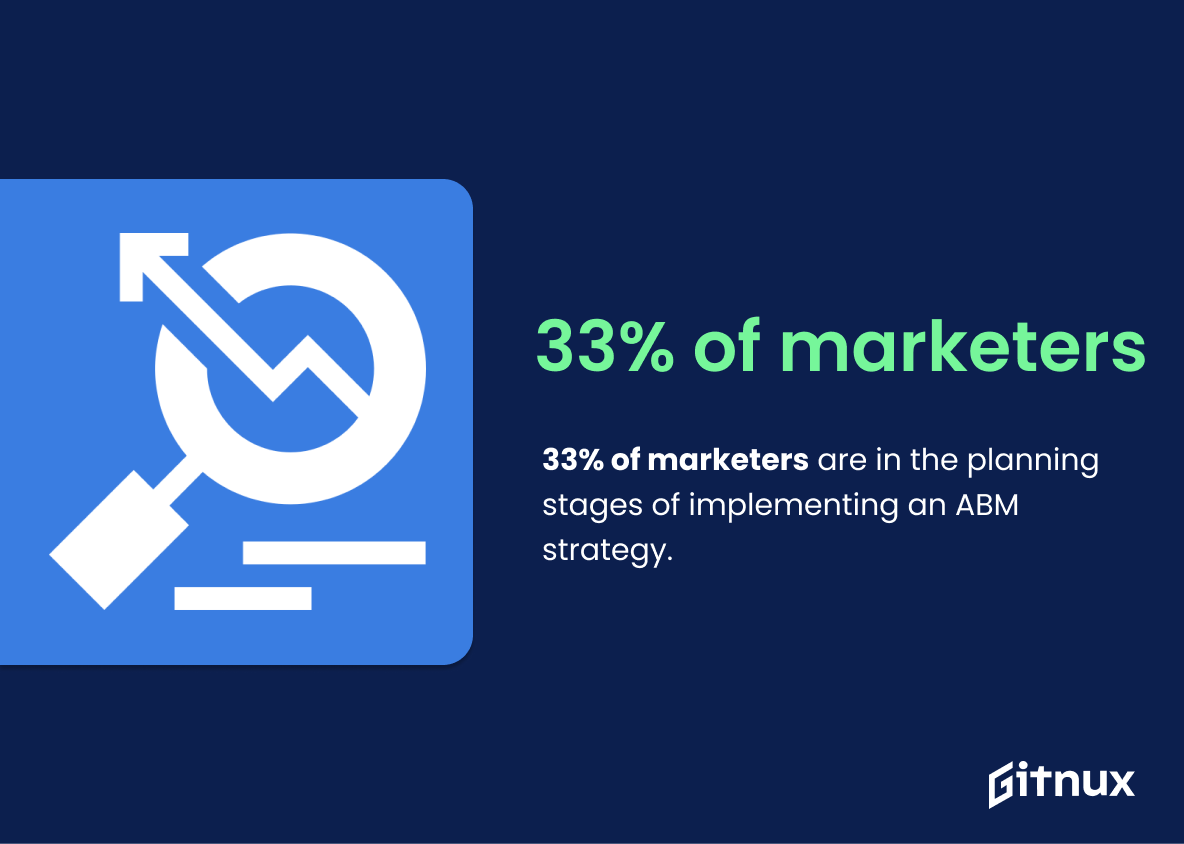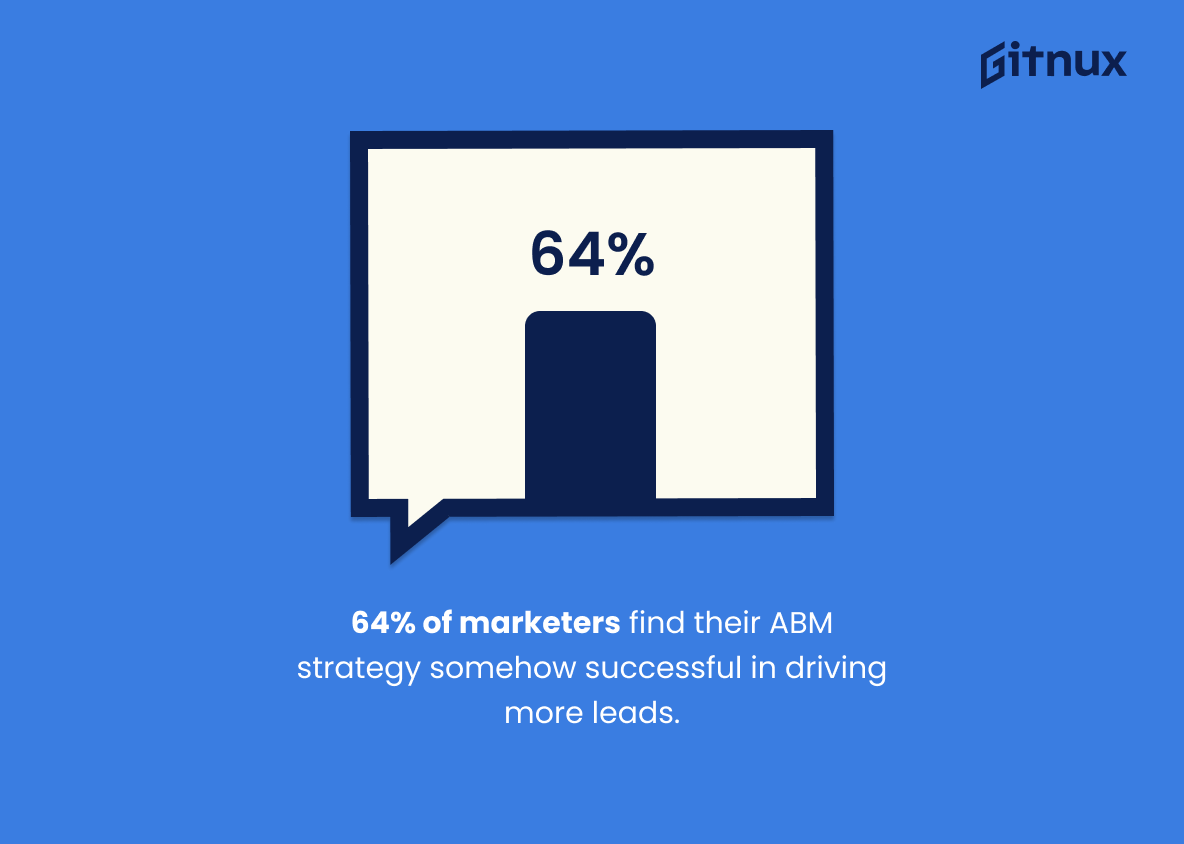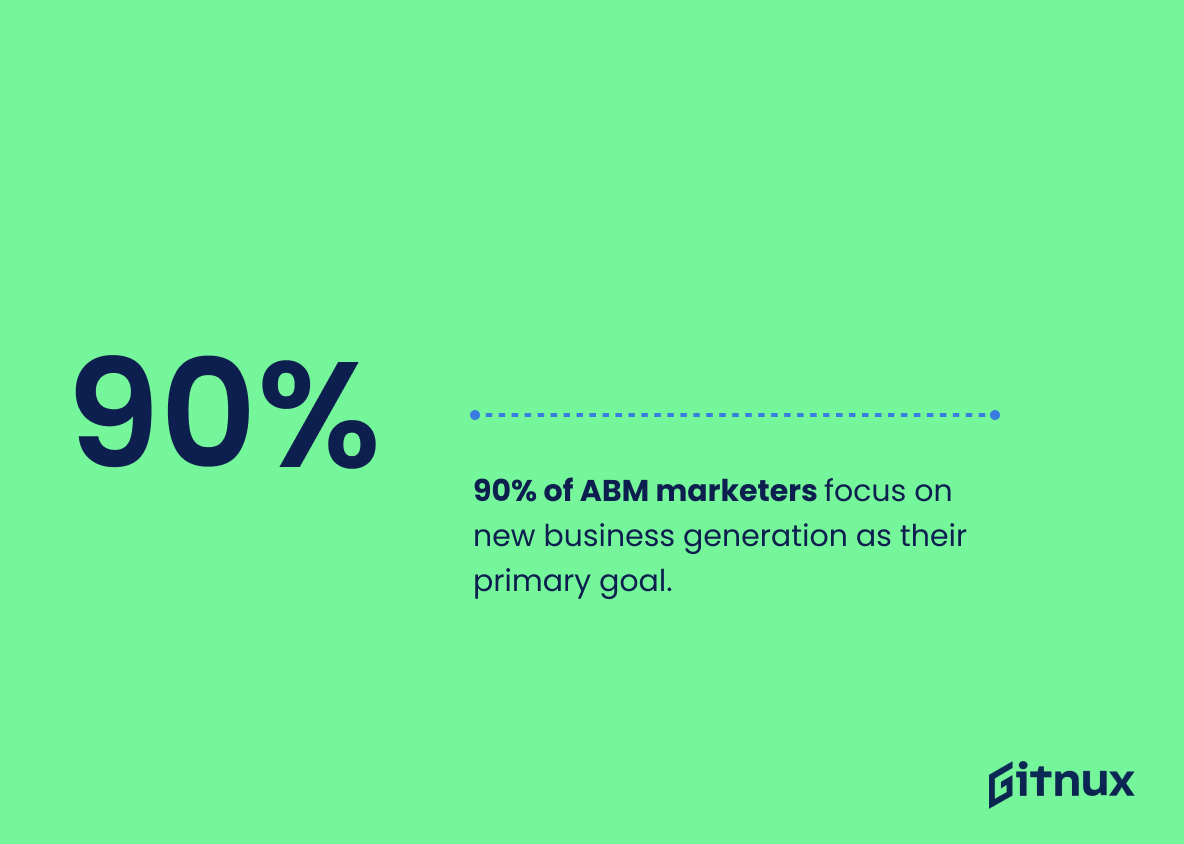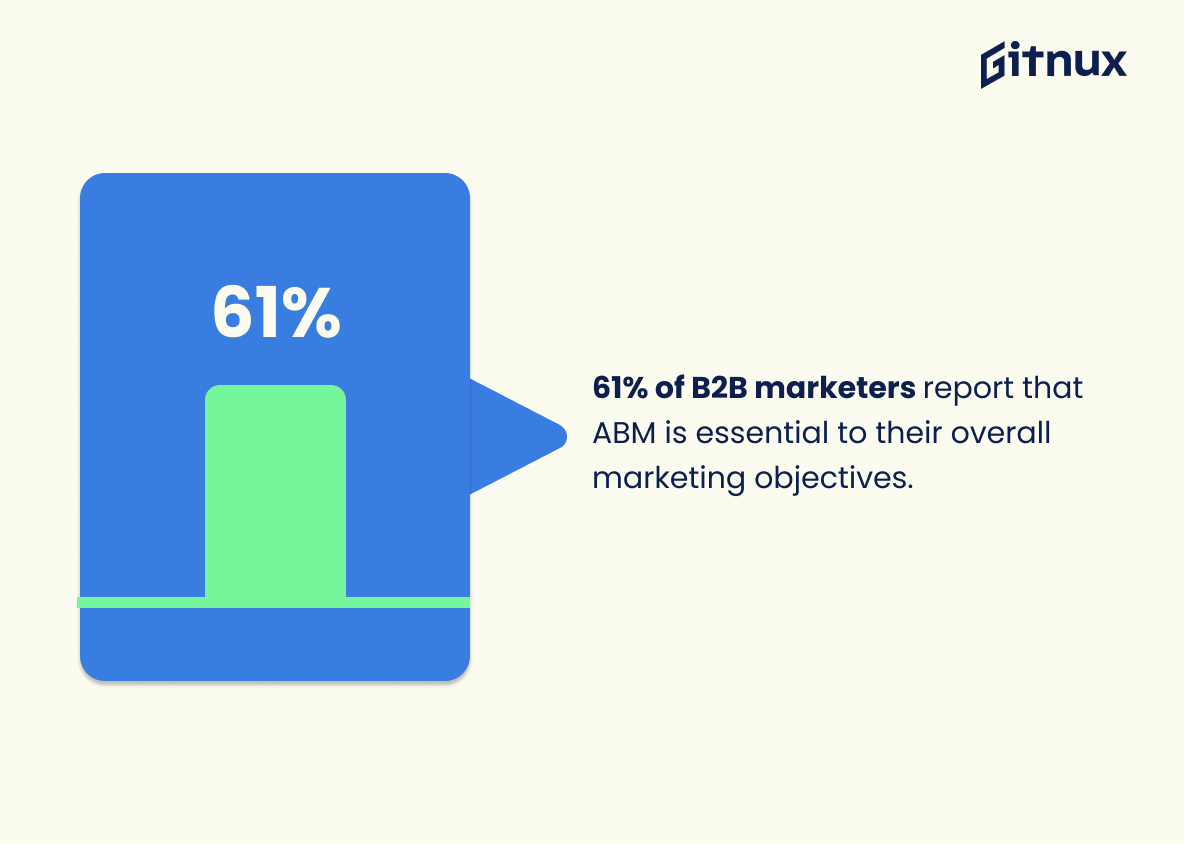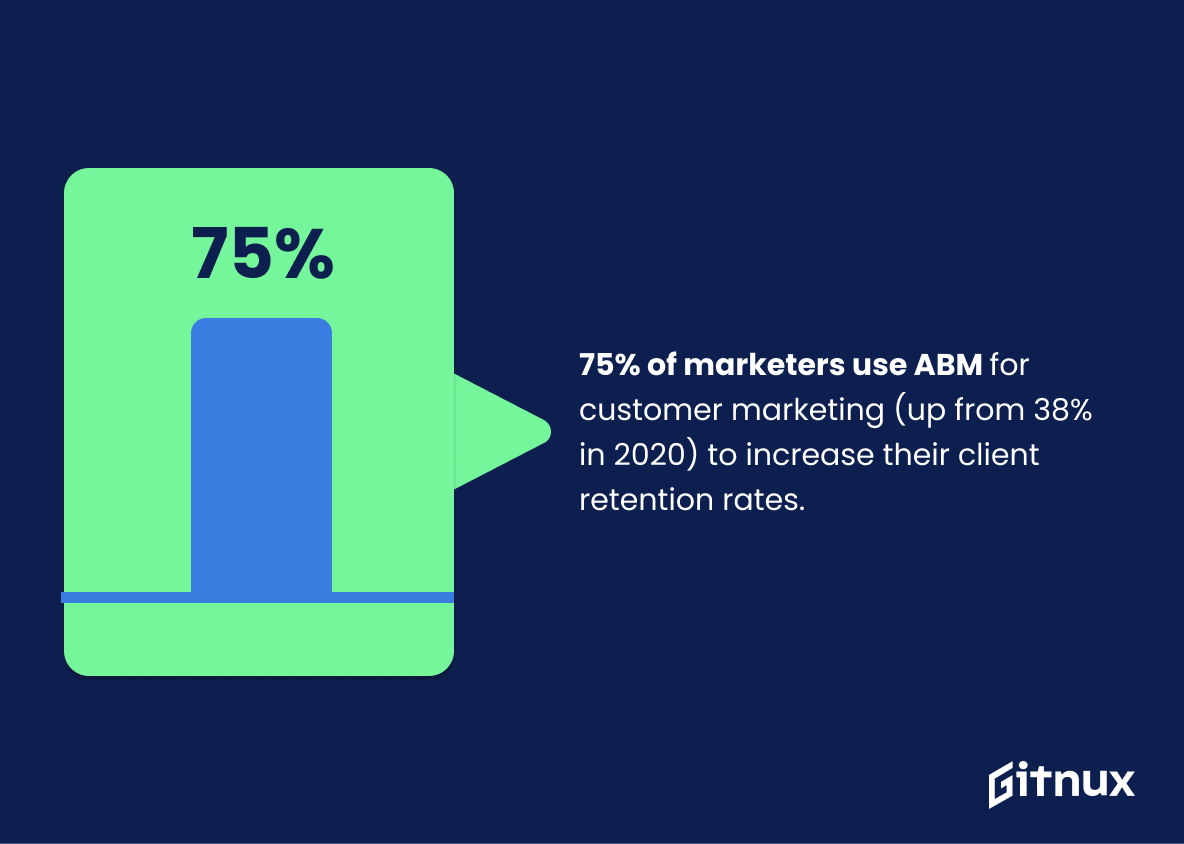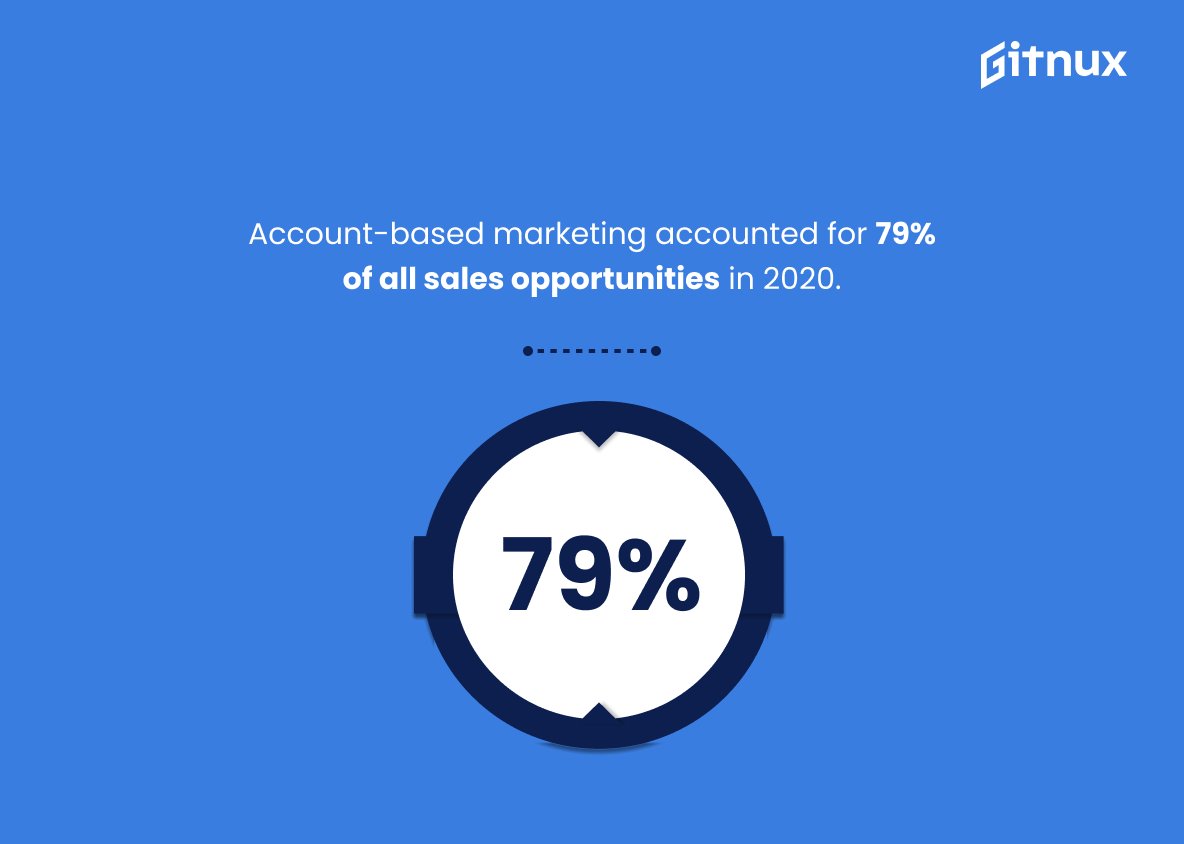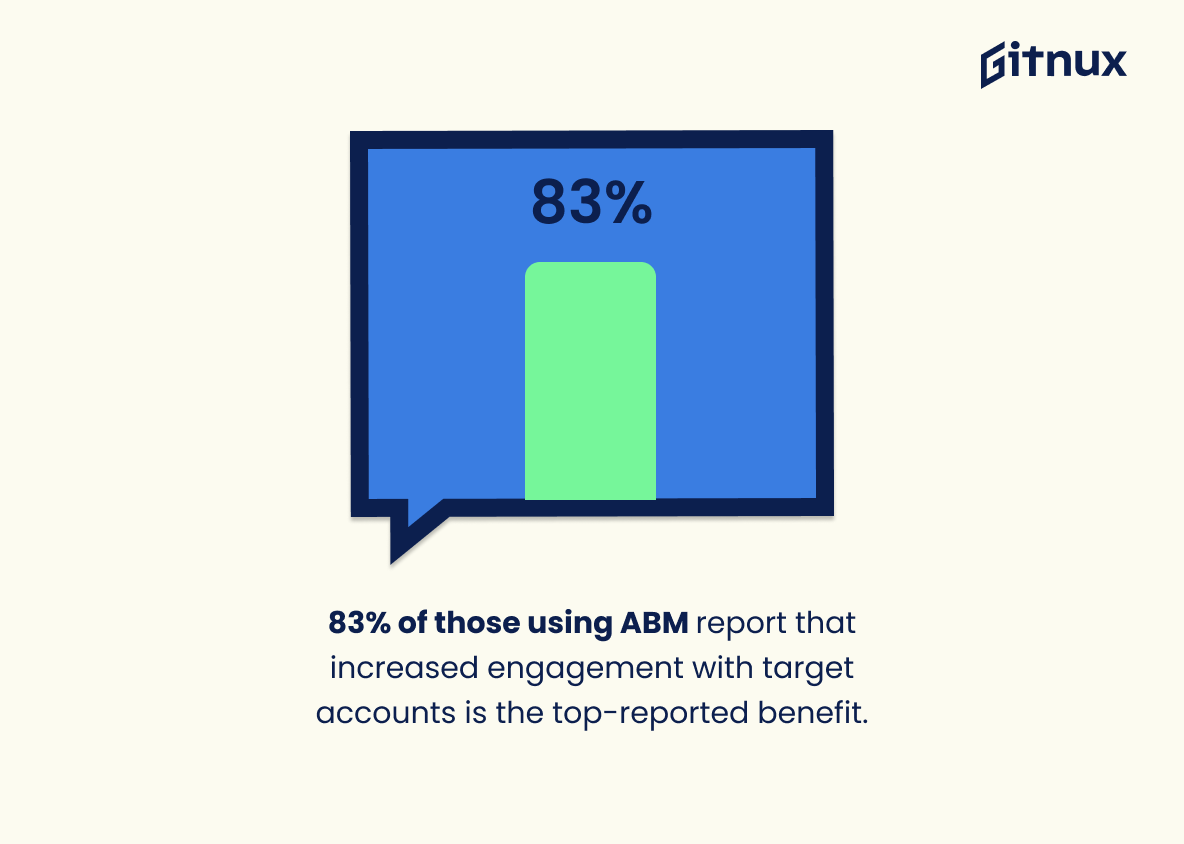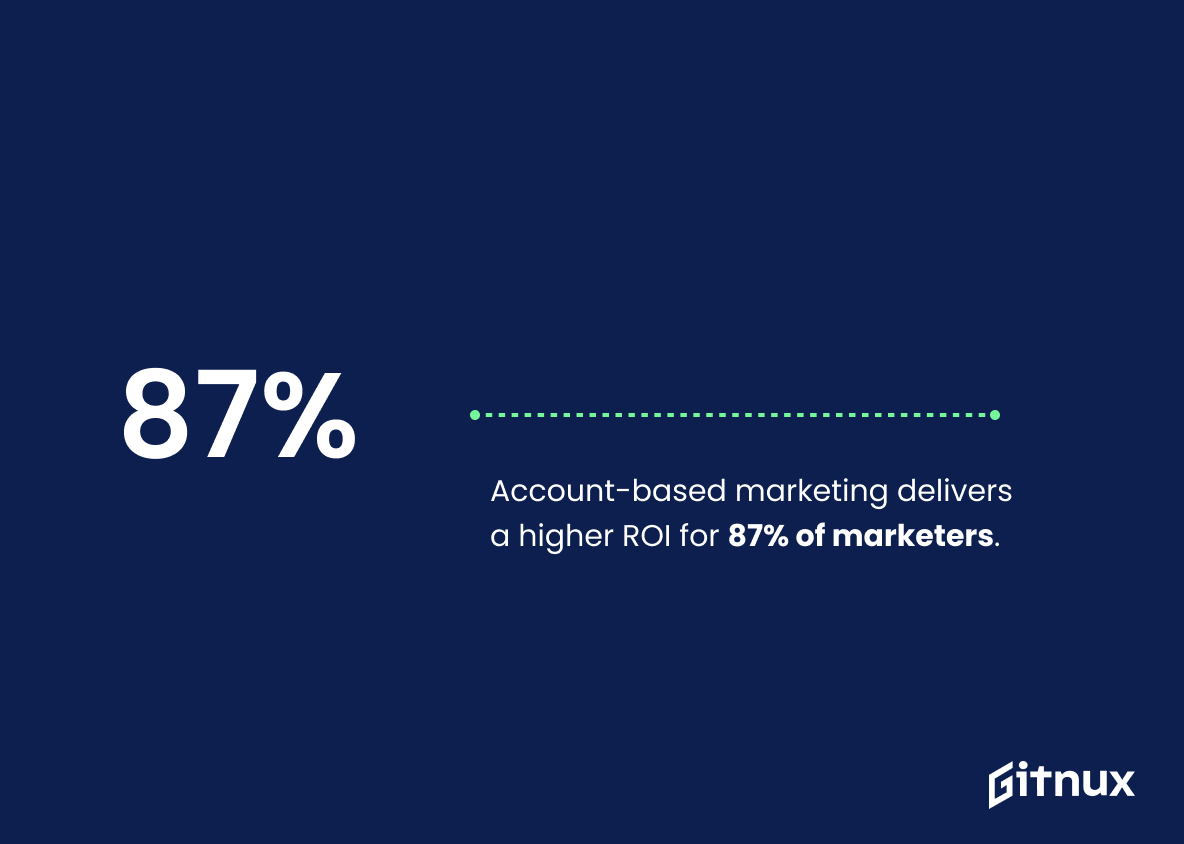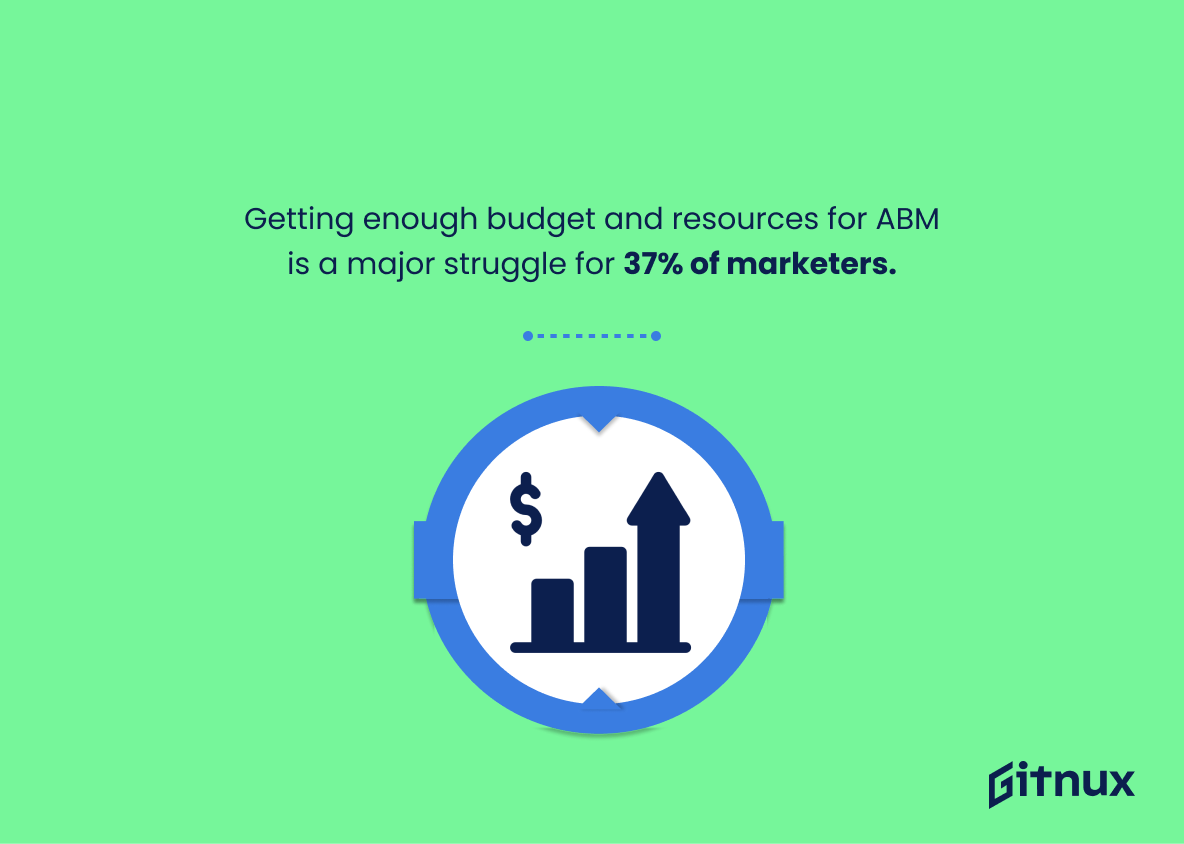Account-based marketing (ABM) is an increasingly popular form of B2B marketing that focuses on targeting individual accounts instead of large groups or an entire market, and was first introduced in 2003. With ABM, marketers can prioritize accounts that are most likely to convert into customers, making it one of the most effective ways to drive ROI.
In this article, we will explore the key ABM statistics and trends that any marketer should be aware of. We will look at how ABM compares to other types of marketing, how it’s used to generate leads, and what it takes to be successful. By the end of this post, you will have a better understanding of how ABM fits into your marketing strategy.
Account-Based Marketing: The Most Important Statistics
On average, companies allocate 37% of their budget to their ABM programs.
Companies that are more aligned in service of the ABM campaigns they are trying to pull off can experience up to a 208% uplift in the revenue contributed by marketing.
General account-based marketing statistics
Today, almost half of all ABM programs are in the expanding and embedded stages, with only 17% representing a “most experienced” cohort. That means that only 17% of marketers have mature ABM marketing strategies, while 83% are still struggling to find the perfect way to deploy ABM. However, 43% of marketers are working on refining and measuring their ABM campaigns.
33% of marketers are in the planning stages of implementing an ABM strategy.
According to Demand Gen Report, 98% of respondents are currently using or plan to use ABM strategies. 57% of respondents are currently using a combination of demand generation tactics and ABM processes to streamline their marketing efforts.
64% of marketers find their ABM strategy somehow successful in driving more leads. And 22% find it very successful.
Small and large companies are now familiar with ABM benefits. Thus, the ABM budget across industries has amplified. Recent studies revealed that 25% of executives spend more in this area.
For 90% of ABM marketers, new business generation is the main goal for their ABM programs, followed by pipeline acceleration (50%) and customer retention (63%).
The budget dedicated exclusively to ABM programs is resilient, with 80% of mature ABM programs keeping their budget remaining or increasing.
61% of B2B marketers report that ABM is essential to their overall marketing objectives.
On average, companies allocate 37% of their budget to their ABM programs.
29% of marketers target 101-500 accounts with an ABM strategy.
67% of brands leverage account-based marketing.
A total of 95% of marketing influencers say an account-based marketing strategy is successful at achieving the top priorities, with 40% describing their ABM strategy success as best-in-class.
84% of companies believe that ABM provides significant benefits for retaining and expanding current client relationships. New customer acquisition is expensive, because acquiring a new customer is 5x as expensive as retaining an existing customer.
86% of marketers get information about their accounts from three significant sources: social media (65%), their database (62%), and IT publishers (60%).
Account-based marketing statistics: What are the ABM benefits?
According to ABM in Action, companies that have implemented ABM have seen a lift in average annual contract value of 171%.
Companies that are more aligned in service of the ABM campaigns they are trying to pull off can experience up to a 208% uplift in the revenue contributed by marketing, as stated by MarketingProfs. The aligned ABM strategy means the marketing and sales team are coordinating to target the same accounts. When both your teams are focusing on the same accounts, it can improve efficiency and bring more results in a short period.
75% of marketers use ABM for customer marketing (up from 38% in 2020) as it helps increase their client retention rates. 40% of B2B marketers report improvement in brand equity and perception. 73% of companies noticed an improvement in account engagement since they implemented an ABM approach.
ABM not only benefits companies by allowing them to generate more revenue, but it also ties marketing directly to closed deals and revenue. Companies using ABM generate 200% more revenue for their marketing efforts.
Account-based marketing accounted for 79% of all sales opportunities in 2020.
The annual contract value for ABM-based deals was 33% higher than non-ABM deals.
Sales-dominated companies have 20% more budget allocated to ABM programs.
60% of companies that use ABM see a revenue increase of at least 10% within 12 months, while 1 in 5 companies experience a revenue increase of 30% or more.
The contract value for ABM-targeted accounts increases by an average of 40% for mid-market accounts and 35% for enterprises. Those numbers can easily result in immense growth for your organization, without spending more money on acquisition.
A whopping 83% of those using ABM report that increased engagement with target accounts is the top-reported benefit.
Nearly 92% of B2B companies said that ABM is “extremely” or “very” important to their marketing efforts.
Account-based marketing delivers a higher ROI for 87% of marketers. The majority of companies that use ABM have sales cycles shorter than 90 days, according to Leadfeeder.
82% of B2B marketers said ABM greatly improves sales and marketing alignment. ABM delivers a 50% reduction in sales time wasted on unproductive prospecting. Companies deploying ABM are 67% better at closing deals when they sync their sales and marketing teams.
86% of organizations say that an ABM approach has helped them increase their win rates.
40% of B2B marketers report improvement in brand equity and perception.
Account-based marketing statistics: What are the main ABM challenges?
Getting enough budget and resources for ABM is a major struggle for 37% of marketers.
Marketers are faced with multiple barriers to overcome when executing ABM initiatives. Identifying target accounts is a particularly challenging task for 36% of marketers. Coordinating marketing and sales efforts as well as reaching specific contacts also prove to be difficult elements of an overall strategy to execute, according to 33% and 29% of marketing professionals, respectively.
19% of marketers report poor data quality to be their main challenge for executing ABM.
For companies with full ABM programs in place, the three biggest challenges are data quality issues (53%), lack of budget (33%) and lack of alignment with sales (31%).
In early-stage ABM programs, the biggest challenges are lack of budget (47%), lack of ability to execute (38%) and lack of tools/tech (33%).
45% of marketers running ABM programs struggle to deliver a personalized customer experience. 36% cite prioritizing accounts as their primary challenge, while 35% report creating and reaching target account lists as a critical difficulty.
According to a Statista survey among B2B marketers in 2022, 40% of respondents said that a lack of internal expertise was their main challenge in executing an ABM strategy. This was followed by 31% of respondents saying the largest challenge was posed by the lack of interest in a specific kind of project. And 23% cited a lack of consensus on the best approach.
Statistics on account-based marketing activities
Over 50% of marketers are focusing a majority of their ABM efforts on finding and attracting new contacts.
Personalization and data management are cornerstones for ABM. As per 56% of marketers, personalized content helps to better target hot accounts. In addition, 43% of marketers find data management the key factor in implementing ABM strategy. It is impossible to deploy an accurate account-based marketing plan without effective data management.
60% of newer ABM practitioners place their focus on customers, while 32% said their focus is on prospects. The remaining 8% focus on partners.
According to Ascend 2 research, the common ABM-oriented marketing activities marketers are taking part in, are: social media (68%), targeted email campaigns (46%), paid advertising (42%), direct mail (34%), specific account targeting (31%), and virtual events (27%) among others.
Last year, as stated by Terminus, 38% of ABM marketers had a customer expansion program. This year, 75% of them either had a customer marketing program in place or are planning one. For mature ABM programs, 80% indicated that they already have one in place.
Companies with full programs in place report being “solid” or “awesome” with sales and marketing alignment (51.6%), a unified account foundation (40%), running plays (40%), measurement (36%) and content/web personalization/ads (30%).
Marketing influencers say a successful account-based marketing strategy targets customers and prospects nearly equally (49% and 46% respectively).
Key indicators and tools for successful ABM strategy
Companies are using information technology and computer software to deploy ABM. Marketers agree that tools required for ABM success are CRM (83%), marketing automation (73%), and LinkedIn (60%).
55% of companies say their ABM strategies are based on customer expansion.
The top 3 ABM key performance indicators for 2021 were sales cycle time, close rate, and conversion rate by stage.
Marketers are using revenue generated from target accounts as a key metric for measuring the success of ABM strategy, according to 56% of those surveyed by Ascend2. Target account engagement, Marketing Qualified Leads (MQLs) and win rate are also meaningful indicators used by 36%, 34% and 28% of marketers, respectively.
The most common measurement of success in ABM is revenue (66%), shortly followed by pipeline in SQLs (65%).
ABM is precise, targeted, personalized and measurable. It provides the highest ROI among B2B marketing tactics and strategies while providing less waste and risk. 80% of marketers who measure ROI say that ABM initiatives outperform other marketing investments. 60% of those who have used ABM for at least a year report a revenue increase of at least 10%, and 19% report a revenue impact of 30% or greater.
87% of companies say that ABM delivers higher ROI than all other types of marketing, according to Tribal Impact. Of companies with full ABM programs in place that measure ROI (54%), the vast majority report a positive ROI from their efforts. 63% report at least a 25% ROI and 46% report at least a 50% return. 5.7% even report a 2x and 6.2% report a 3x return.
79% of active ABM adopters have been successfully generating ROI. 76% of respondents report higher ROI with ABM than with other tactics.
The future perspectives on account-based marketing
One-third of marketing vice presidents plan to grow investment in ABM campaigns by 30%.
The ABM market is estimated to reach 2.1 billion USD by 2027.
The 7% reduction in the headcount for ABM teams has been seen lately. This shows how ABM is stepping into the mainstream with more marketing teams adopting it.
Companies with strong ROI from ABM plan to invest the most in: direct mail (64%), content (55%) and target account selection (55%).
Check out our latest Content Marketing Statistics
53% of marketers agree that creating new opportunities for sales is a top priority for their ABM strategy to achieve. Another main focus is generating more revenue from existing customers, according to 42% of those marketing professionals surveyed. Followed by identifying new target accounts (35%) and increasing the efficiency of the marketing budget (32%).
35% of B2B marketing leaders are prioritizing marketing alignment with other departments over the past two years. As a result, ABM is turning out to be a sales acceleration point for more upstream and higher-quality opportunities, leading to revenue growth.
40% of companies use the account-based marketing plan to grow their ABM efforts “a lot” in the coming years.
86% of ABM leaders and B2B marketers plan to invest more money in tools, campaign templates, and processes to scale ATM programs.
Supplementary Statistics
84% of B2B marketers claim that account-based marketing delivers higher ROI than other types of marketing.
It is a highly profitable strategy for B2B marketers. It highlights the potential of account-based marketing to generate a higher return on investment than other types of marketing, making it an attractive option for businesses looking to maximize their marketing efforts.
97% of marketers reported that ABM had a somewhat higher or much higher ROI than other marketing initiatives.
Marketers are seeing tangible results from their ABM initiatives, with a much higher return on investment than other marketing strategies. This is an invaluable insight for any business looking to maximize their marketing efforts and maximize their ROI.
60% of companies plan to invest in ABM technology (2020).
More and more companies are recognizing the potential of ABM technology to help them reach their goals and objectives. This statistic is a testament to the growing importance of ABM technology in the modern business landscape and serves as a reminder of the need for businesses to stay ahead of the curve when it comes to leveraging the latest technology.
B2B marketers report an 85% increase in engagement with ABM programs.
When B2B marketers invest in ABM, they can expect to see a significant increase in engagement. This is an important statistic to consider when evaluating the effectiveness of ABM programs, and it should be taken into account when making decisions about how to best allocate resources for marketing efforts.
91% of B2B marketers regard ABM as extremely or very important.
The vast majority of B2B marketers recognize the value of ABM and are actively investing in it. This statistic is a testament to the effectiveness of ABM and its potential to drive business growth.
40% of organizations plan to implement at least one new ABM tool.
ABM is no longer just a trend, but a viable marketing strategy that is being adopted by a large number of organizations. This statistic is a clear indication that ABM is here to stay.
Sales cycles that involve ABM are 40% shorter.
By shortening the sales cycle, businesses can quickly and efficiently close deals and maximize their return on investment. This is especially important for businesses that are looking to maximize their ROI and increase their bottom line.
56% of the high-performing account based marketing teams are using ABM to manage their accounts.
The majority of high-performing teams are utilizing ABM to manage their accounts. This indicates that ABM is a powerful tool for managing accounts and achieving success. It is a valuable insight for those considering implementing ABM into their own strategies, as it demonstrates the potential for success.
Conclusion
Account-Based Marketing is a powerful tool to help businesses reach their desired goals. Through leveraging the right data and technology, ABM can provide businesses with the insights they need to make informed decisions and create highly targeted campaigns.
The statistics indicate that ABM is an effective way to increase website traffic, engagement, and leads, all while saving time and money. With the right strategy and implementation, account-based marketing can be a powerful tool for businesses to grow their customer base and increase their bottom line.
Resources
ABM Leadership Alliance: “Moving to ABM Maturity: 2019 ABM Benchmark Study”, cited January 2023. (Source)
ABM in Action: “ABM Alliance Research Shows Payoffs In Retention & Lifetime Value”, cited January 2023. (Source)
Act-On: “10 Benefits Of Account-Based Marketing”, cited January 2023. (Source)
Ascend2: “Account-based marketing initiatives”, cited January 2023. (Source)
Ascend2: “Account-based marketing approach”, cited January 2023. (Source)
CXL: “9 Account-based Marketing Case Studies”, cited January 2023. (Source)
Demand Gen Report: “2020 ABM Benchmark Survey Report: Doubling Down On ABM”, cited January 2023. (Source)
Demand Gen Report: “2021 ABM Benchmark Survey: Personalization & Engagement Data Becoming Top Drivers For Account Selection, Segmentation, Messaging & Other GTM Key Strategies”, cited January 2023. (Source)
Forbes: “14 Benefits Of Account-Based Marketing”, cited January 2023. (Source)
Leadfeeder: “Account Based Marketing Strategy: A Step-by-Step Guide”, cited January 2023. (Source)
MarketingProfs: “Two Great Tactics That Work Great Together, B2B Social Selling and ABM: LinkedIn’s Ty Heath on Marketing Smarts”, cited January 2023. (Source)
Research and Markets: “Account-based Marketing: Global Strategic Business Report”, cited January 2023. (Source)
Statista: “Leading challenges faced by B2B marketers in executing their account-based strategy in the United States as of February 2022”, cited January 2023. (Source)
Strategic ABM: “Why 2021 is the Year of ABM: 23 Account-based Marketing Stats”, cited January 2023. (Source)
Terminus: “The 2020 State of ABM Report”, cited January 2023. (Source)
Tribal Impact: “43 Account Based Marketing Statistics: From Buzz To Mainstream Impact”, cited January 2023. (Source)
UnboundB2B: “15 Account-Based Marketing Statistics to Know in 2023”, cited January 2023. (Source)
UserGems: “65 account-based marketing stats every revenue marketer needs to know”, cited January 2023. (Source)
